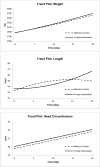Influence of H-HOPE intervention for premature infants on growth, feeding progression and length of stay during initial hospitalization
- PMID: 25742287
- PMCID: PMC4520757
- DOI: 10.1038/jp.2015.11
Influence of H-HOPE intervention for premature infants on growth, feeding progression and length of stay during initial hospitalization
Abstract
Objective: To examine whether premature infants receiving the maternally administered H-HOPE (Hospital to Home Transition-Optimizing Premature Infant's Environment) intervention had more rapid weight gain and growth, improved feeding progression and reduced length of hospital stay, compared with controls.
Study design: Premature infants born at 29-34 weeks gestational age and their mothers with at least two social-environmental risk factors were randomly assigned to H-HOPE intervention (n=88) or an attention control (n=94) groups. H-HOPE consists of a 15-min multisensory intervention (Auditory, Tactile, Visual and Vestibular stimuli) performed twice daily prior to feeding plus maternal participatory guidance on preterm infant behavioral cues.
Result: H-HOPE group infants gained weight more rapidly over time than infants in the control group and grew in length more rapidly than control infants, especially during the latter part of the hospital stay.
Conclusion: For healthy preterm infants, the H-HOPE intervention appears to improve weight gain and length over time from birth to hospital discharge.
Conflict of interest statement
Conflicts of Interest: There is not any competing financial interests in relation to this publication.
Figures
Comment in
-
Optimizing parental involvement in caring for preterm infants.J Perinatol. 2015 Sep;35(9):669-70. doi: 10.1038/jp.2015.60. J Perinatol. 2015. PMID: 26310314 No abstract available.
References
-
- Funkquist EL, Tuvemo T, Jonsson B, Serenius F, Nyqvist K. Preterm appropriate for gestational age infants: size at birth explains subsequent growth. Acta Paediatr. 2010;99(12):1828–1833. - PubMed
-
- Bhatia J. Growth curves: how to best measure growth of the preterm infant. J Pediatr. 2013;162(3 Suppl):S2–6. - PubMed
-
- Blackwell MT, Eichenwald EC, McAlmon K, Petit K, Linton PT, McCormick MC, et al. Interneonatal intensive care unit variation in growth rates and feeding practices in healthy moderately premature infants. J Perinatol. 2005;25(7):478–485. - PubMed
-
- Ehrenkranz RA, Younes N, Lemons JA, Fanaroff AA, Donovan EF, Wright LL, et al. Longitudinal growth of hospitalized very low birth weight infants. Pediatrics. 1999;104(2 Pt 1):280–289. - PubMed
-
- Roggero P, Gianni ML, Amato O, Orsi A, Piemontese P, Cosma B, et al. Postnatal growth failure in preterm infants: recovery of growth and body composition after term. Early Hum Dev. 2008;84(8):555–559. - PubMed
Publication types
MeSH terms
Grants and funding
LinkOut - more resources
Full Text Sources
Other Literature Sources
Medical


